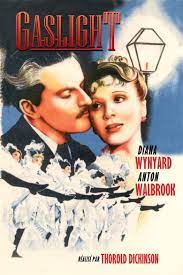
The resident of 12 Pimlico Square in London, Alice Barlow (Marie Wright), is viciously murdered and her valuable rubies are missing. The killer is never found. The house stays empty for years until it is purchased by Paul Mallen (Anton Walbrook) and his bride, Bella Mallen (Diana Wynyard). Before they move in Paul has the house renovated and the top two floors walled off. The Mallens employ a cook, Elizabeth (Minnie Rayner), and a parlor maid, Nancy (Cathleen Cordell).
E. G. Rough (Frank Pettingell) owns and operates a livery stable. One day, coming back from church he sees Paul and Bella enter number 12 Pimlico. Rough is a former policeman who remembers the murder at that address because he was part of the investigation. He also recognizes the man entering the house. He tells his employee, Cobb (Jimmy Hanley), that Alice’s nephew Louie Bauer lives there now. Cobb maintains that the owner’s name is Mallen and not Bauer. Cobb got his information from the maid, Nancy. Rough’s spidey sense begins to tingle. Why would Bauer move into his aunt’s old house, and do so under an alias?
Not long after they move in, Bella begins to have trouble remembering things and misplacing items. Paul starts to lose patience with her. Bella doesn’t know, but Paul is the one hiding things and blaming her. His mind games begin to affect Bella. Paul is slowly and systematically trying to make Bella believe that she is going insane. As Bella falls for Paul’s deception, she starts to really believe that she is losing her grip on reality.
“Gaslight” was released in 1940 and was directed by Thorold Dickinson. It is a British film noir mystery and psychological thriller. The film was released in America as “Angel Street”. The movie was based on the play “Gas Light” by Patrick Hamilton. An American remake of the play was done in 1944 by MGM starring Charles Boyer and Ingrid Bergman. The 1940 version follows the play closer than the 1944 remake. MGM attempted to have all the prints of the 1940 film destroyed, which itself would be a form of Gaslighting since MGM tried to make it look like the 1940 version never existed. Fortunately, a few prints managed to survive, one of them being a copy that Dickinson had. The film wasn’t released in the U.S. until 1952.
In seeing the two films I found they were both excellent and compelling but for different reasons. The performances of Boyer and Bergman are spectacular and the buildup to the end was powerful and totally noir in the 1944 version. In the1940 film I found the performances just as good, but Walbrook’s performance was far more intense and sinister than Boyer. I hated Walbrook’s Paul Mallen a lot more than Boyer’s Gregory Anton. The whole feel of the British version is darker and more menacing, almost claustrophobic. The lower production values add to the overall ominous atmosphere.
Paul Mallen is doing what a lot of slimy men did in the 1800’s when they wanted to get rid of a wife or mistress. Physical abuse of one’s wife was common since women were basically chattel. If a man wished to get rid of his wife, and killing wasn’t an option, he would tell a psychiatrist that she was insane and, since it was a man who made the claim, the doctor would go along and have the wife committed to an asylum. Sometimes a bribe to the doctor went along with the claim of insanity. In London the asylum was called Bedlam. There were many reasons to send your wife to Bedlam and a lot of them had to do with a man’s ego, but there were other dubious reasons as well. Paul’s method of silencing his wife had an additional cruel vein running through it.

